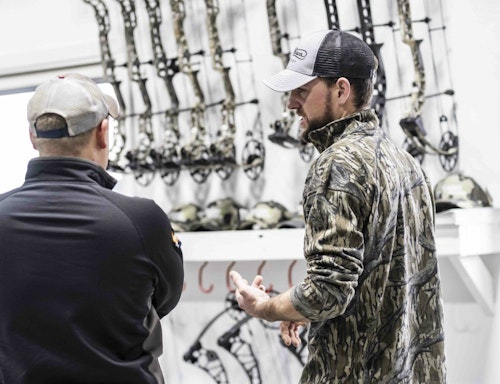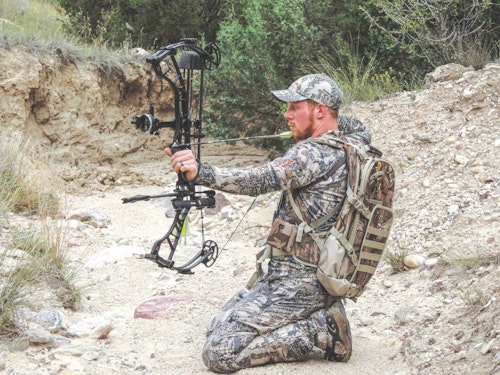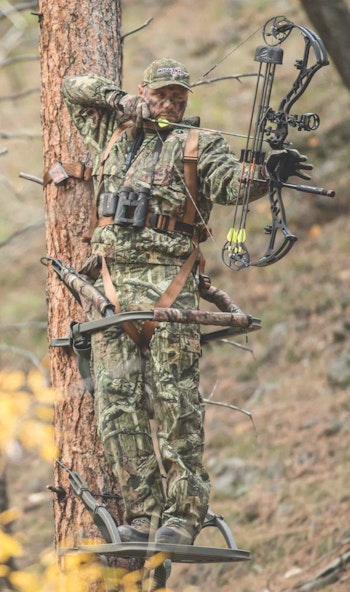I don’t know a single bowhunter who picked up a bow and immediately became deadly. Yes, some archers reach that status faster than others, but none are instant experts. In fact, I believe that Malcom Gladwell’s 10,000-hour rule, which holds that one must have practiced a given activity for 10,000 hours before becoming good at it, applies very well to archery and bowhunting. Bowhunting is such an intricate and involved sport, and mastery comes with diligent practice and acute attention to every detail.
Of course, even the sharpest bowhunters don’t know everything or win every single time they release an arrow. Why? Because bowhunting, unlike playing a guitar on your couch when no one else is home, involves countless variables and uncontrollable factors that steal success. In other words, no two bowhunting shots happen exactly the same way, and despite the uncontrollable factors, you must maintain the same fundamentals as when you practice if you want to shoot consistently well afield.
In this article, I’ll discuss several points that have helped me shoot more accurately amidst difficult hunting conditions. If you’ve struggled, even occasionally, with closing the deal (I have), I believe you will find these tips helpful.
1. Proper Equipment
Most proficient bowhunters could, if given the opportunity, shoot well with any of today’s advanced compound bows. But, there’s a difference between shooting well and having unrivaled confidence in your bow. I’m talking about a confidence level that prompts an internal feeling like, “I’m deadly with this bow,” instead of merely, “I shoot pretty well with this bow.”
After shooting bows for 25 years, I’ve concluded that, yes, there are other principles that contribute to deadly shooting — we’ll discuss those later — but none are as important as being outfitted with the best-fitting bow and accessories. When you have a bow that flat out fits you, it’s hard not to excel and feel deadly.

I believe the grip is a bow’s most important attribute. It must feel natural the moment your hand slides onto it. If you handle several bows while shopping for a new one, there’ll always be one that just feels better than all of the rest. From there, consider how it balances and maneuvers. Draw it back and anchor. Do you like the valley and the back wall? Everything about it must be positive. If you have any negative inkling about the bow, keep shopping. There are enough bows on the market that you need not settle for something you don’t love from top to bottom.
Obviously, the more time you spend with a trained bow technician while getting your bow outfitted and adjusted, the better. You must get everything right from the get-go: draw length, draw weight, peep-sight position, etc. When these points are addressed, then you’re ready to take the next step.
2. Putting In the Time
Once you’ve selected a bow and have it outfitted with accessories, you must develop a relationship with your new equipment in order to reach deadly status. My friend and fellow outdoor scribe, Mark Kayser, refers to a good-fitting bow that you’ve spent a lot of time with as “an extension of your arm.” In other words, it basically becomes as familiar to you as your hand.
I don’t condone when folks dust off their bows a couple of weeks before archery season opens. Almost to a fault, I practice my butt off long, long before upcoming hunts. I’ve even been known to trudge through deep snow in the dead of winter to shoot a few arrows just to stay sharp. I’ll even admit that I’ve over-practiced occasionally, which can actually be detrimental to achieving deadly status. Too many repetitions on the range is like too many repetitions in the gym. Muscle exhaustion poses problems with compromised form and poor performance, which hurts confidence more than helps it. So, it pays to find medium ground in the practice realm.
Today, I end my practice sessions when I’m ahead. If I’m shooting at 80 yards and pack all three arrows in a softball-sized group, I don’t try to prove to myself that I can do it again. Instead, I either end my session right there or walk up to 20 yards and shoot one more arrow with heavy concentration on shooting form and shot execution. Whenever you needlessly try to prove to yourself that you can do something difficult over and over, you’ll probably fail eventually, and then your confidence could plunge. Quit when you’re ahead rather than exhaust your muscles.
Further, shooting dozens of repetitions at 80 yards is hardly realistic bowhunting practice. I believe you’re better off shooting one arrow at a time, preferably with a broadhead, from random locations and putting great emphasis on making kill shots every single time. This is not only more realistic, but it’ll build your confidence faster and make you feel deadlier.
3. Focus On Shooting Form
Like ill-gotten gains, hitting bull’s-eyes using poor shooting form is little to be proud of. Plus, few folks actually excel at archery with poor shooting form. Obviously, poor shooting form will only worsen with the encumbrances and awkward angles relative to real bowhunting conditions. Poor shooting form is to blame for many misses and poor hits in the bowhunting woods. So, why not give the details their due attention and improve your shooting consistency simultaneously?
Bow torque is the most common form flaw I see. Folks get their hands too involved with the grip, and thus tweak the bowstring right or left of the cam/wheel track. This causes poor arrow departure and leads to inconsistent grouping. Add a fixed-blade broadhead to the equation, and the problem will magnify.
Rather than get your hand too involved, loosen your death clench and let the grip’s pressure point situate right between your thumb and palm. I use less than half of my palm to grip the bow, and you’ll notice that most champion archers grip similarly. We do it to avoid twisting the bow right or left as we draw, anchor, hold and shoot, and our arrows leave our bows much truer as the result.
Once you master your gripping style, move on to stance. You might find a stance that works better for you, but I prefer to place my right foot (I’m right-handed) 90 degrees to the target and my left foot at shoulder’s width from my right foot, pointing it about 75 degrees to the target, which slightly opens my stance toward the target. This configuration provides great stability and helps with target acquisition.
When I draw my bow, I primarily use my back muscles, which stabilizes my shoulders throughout the cycle so I can dodge strain or worse injuries. Pretend you’re squeezing a golf ball between your shoulder blades as you draw, anchor and hold.
At full draw, I relax enough to steady my sight picture, but not enough to cause an unintended jerk or letdown. I find a happy medium by aligning my release-arm elbow directly away from the target, pointing it slightly upward toward the sky so my form doesn’t collapse. My bow-arm elbow is bent slightly downward and outward from the string path, my shoulder being dropped and virtually locked in place, adding more stability. You’ll see many different successful archers and bowhunters do things a bit differently, so you’ll need to find what works for you, but be sure to get some lessons from an archery coach if at any point you feel like you’re off track.
Release length has as much to do with shooting form as draw length. A wrist-strap style release that’s too long will cause you to reach for the trigger when you’re ready to begin executing the shot. This is unnatural movement and will cause accuracy inconsistencies. And, reaching for the trigger naturally instigates trigger punching, which is usually the fastest road to rock bottom when shooting at game. I have adjusted the trigger on my Spot-Hogg Wiseguy release so it fits into my index finger’s second knuckle crease, and that positioning has been great for me in terms of using back tension to execute my shots.
4. Train Your Brain
I’ve had numerous ups and downs on this rollercoaster part of the shooting game, and I’m sure you’ve had yours, too. So much of the mental program becomes subconscious in the woods during your hunt, often because shot opportunities generally happen pretty fast. Think of it as flying on autopilot.
Now, if you don’t break down the entire shot cycle when you’re practicing and really focus on each aspect, your mental program will also become subconscious when practicing. This is especially true when you have many distractions as you practice — work deadlines, relationship drama, children playing and screaming in the background, etc. It’s a recipe for disaster. When you carry out practice sessions subconsciously, that is, your mind is elsewhere, you’re setting up to fail when you hunt. Why? Because you’ve trained your brain that shooting an arrow is just one task that requires little thought when indeed it is not.
When you mentally separate each task it takes to properly shoot an arrow — from nocking the arrow to watching it strike the target — you’re programming your mind that it is indeed a step-by-step procedure that requires forethought and attention from start to finish. More than that, you’re programming yourself to perform these tasks correctly and individually. Then, when crunch time unfolds in the woods, you’ll subconsciously be able to tackle each step with great skill.

5. Use Positive Reinforcement
Unless you have steel veins, shooting at an animal is an anxiety-filled event. You’ve worked hard and/or paid a lot of money to orchestrate the shot opportunity in front of you, and missing or wounding the animal involves many consequences. You might get one good opportunity to take the buck you want in an entire season, and some folks hunt a lifetime to get it. Regardless, the opportunity is huge, and you must capitalize when it arrives, despite the anxiety.
I believe the best way to perform under pressure is to rehearse the steps it takes to execute a great shot just as if the animal were a target. It’s easier to say than do, but you must focus on the steps to the process rather than the bigness of the moment.
One quote I’ve used in previous articles that came from a phone call with archery legend Randy Ulmer has helped me immeasurably. “Most bowhunters meltdown when they’re about to shoot at an animal,” Ulmer said. “I hate to admit it, but it happens to me ,too. What helps me most is that I admit, yes, I’m scared to death, and, yes, my bow will shake. So, I resolve to make the very best shot possible under the circumstances at hand. I find that if I have perfect form, even if my pin is moving, my arrow will usually hit in the center of that movement.”
Ulmer’s outlook really helps me manage my anxiety during intense moments.
I prefer to hunt every chance I get so that I’m around game and shooting at game regularly. Nothing instills confidence like pin-on-hide practice. Hogs and turkeys are great extracurricular hunts that’ll challenge your nerves and shooting form in live hunting situations. When you can perform under the pressure these hunts impose, it provides solid positive reinforcement for the next anxiety-filled shot scenario you’ll encounter in the deer or elk woods.
If you want to shoot better now, be progressive about applying the steps I’ve discussed here, and improvement can be yours.
Sidebar: Treestand Shooting Form
Few bowhunters practice from elevation prior to hunting. Then, when they hunt from a treestand, their shooting form crumbles. Many drop their bow arms to acquire their targets, which fudges their anchor points and then their accuracy.
The best way to shoot from a treestand is to draw back as if you’re on the ground, settle into your anchor point and center your sight housing in your peep sight, then slowly bend at the waist until you acquire your target without changing anything above your waist. This will allow you to keep good shooting form despite the downward shot angle. This is something you should practice extensively before you hunt from a treestand.








